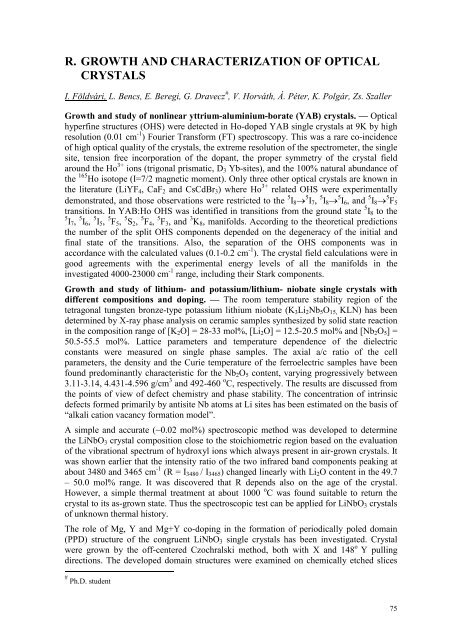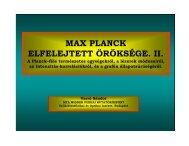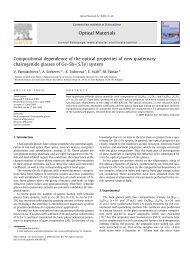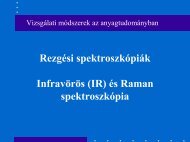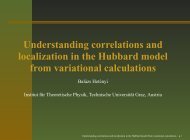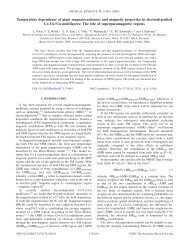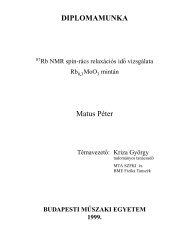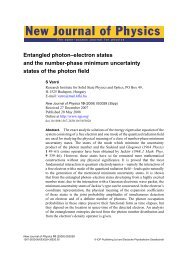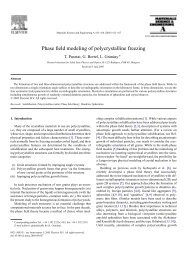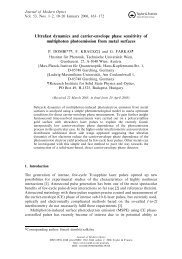ANNUAL REPORT - MTA SzFKI
ANNUAL REPORT - MTA SzFKI
ANNUAL REPORT - MTA SzFKI
You also want an ePaper? Increase the reach of your titles
YUMPU automatically turns print PDFs into web optimized ePapers that Google loves.
R. GROWTH AND CHARACTERIZATION OF OPTICAL<br />
CRYSTALS<br />
I. Földvári, L. Bencs, E. Beregi, G. Dravecz # , V. Horváth, Á. Péter, K. Polgár, Zs. Szaller<br />
Growth and study of nonlinear yttrium-aluminium-borate (YAB) crystals. — Optical<br />
hyperfine structures (OHS) were detected in Ho-doped YAB single crystals at 9K by high<br />
resolution (0.01 cm -1 ) Fourier Transform (FT) spectroscopy. This was a rare co-incidence<br />
of high optical quality of the crystals, the extreme resolution of the spectrometer, the single<br />
site, tension free incorporation of the dopant, the proper symmetry of the crystal field<br />
around the Ho 3+ ions (trigonal prismatic, D 3 Yb-sites), and the 100% natural abundance of<br />
the 165 Ho isotope (I=7/2 magnetic moment). Only three other optical crystals are known in<br />
the literature (LiYF 4 , CaF 2 and CsCdBr 3 ) where Ho 3+ related OHS were experimentally<br />
demonstrated, and those observations were restricted to the 5 I 8 → 5 I 7 , 5 I 8 → 5 I 6 , and 5 I 8 → 5 F 5<br />
transitions. In YAB:Ho OHS was identified in transitions from the ground state 5 I 8 to the<br />
5 I 7 , 5 I 6 , 5 I 5 , 5 F 5 , 5 S 2 , 5 F 4 , 5 F 3 , and 3 K 8 , manifolds. According to the theoretical predictions<br />
the number of the split OHS components depended on the degeneracy of the initial and<br />
final state of the transitions. Also, the separation of the OHS components was in<br />
accordance with the calculated values (0.1-0.2 cm -1 ). The crystal field calculations were in<br />
good agreements with the experimental energy levels of all the manifolds in the<br />
investigated 4000-23000 cm -1 range, including their Stark components.<br />
Growth and study of lithium- and potassium/lithium- niobate single crystals with<br />
different compositions and doping. — The room temperature stability region of the<br />
tetragonal tungsten bronze-type potassium lithium niobate (K 3 Li 2 Nb 5 O 15, KLN) has been<br />
determined by X-ray phase analysis on ceramic samples synthesized by solid state reaction<br />
in the composition range of [K 2 O] = 28-33 mol%, [Li 2 O] = 12.5-20.5 mol% and [Nb 2 O 5 ] =<br />
50.5-55.5 mol%. Lattice parameters and temperature dependence of the dielectric<br />
constants were measured on single phase samples. The axial a/c ratio of the cell<br />
parameters, the density and the Curie temperature of the ferroelectric samples have been<br />
found predominantly characteristic for the Nb 2 O 5 content, varying progressively between<br />
3.11-3.14, 4.431-4.596 g/cm 3 and 492-460 o C, respectively. The results are discussed from<br />
the points of view of defect chemistry and phase stability. The concentration of intrinsic<br />
defects formed primarily by antisite Nb atoms at Li sites has been estimated on the basis of<br />
“alkali cation vacancy formation model”.<br />
A simple and accurate (~0.02 mol%) spectroscopic method was developed to determine<br />
the LiNbO 3 crystal composition close to the stoichiometric region based on the evaluation<br />
of the vibrational spectrum of hydroxyl ions which always present in air-grown crystals. It<br />
was shown earlier that the intensity ratio of the two infrared band components peaking at<br />
about 3480 and 3465 cm -1 (R = I 3480 / I 3465 ) changed linearly with Li 2 O content in the 49.7<br />
– 50.0 mol% range. It was discovered that R depends also on the age of the crystal.<br />
However, a simple thermal treatment at about 1000 o C was found suitable to return the<br />
crystal to its as-grown state. Thus the spectroscopic test can be applied for LiNbO 3 crystals<br />
of unknown thermal history.<br />
The role of Mg, Y and Mg+Y co-doping in the formation of periodically poled domain<br />
(PPD) structure of the congruent LiNbO 3 single crystals has been investigated. Crystal<br />
were grown by the off-centered Czochralski method, both with X and 148 o Y pulling<br />
directions. The developed domain structures were examined on chemically etched slices<br />
# Ph.D. student<br />
75


